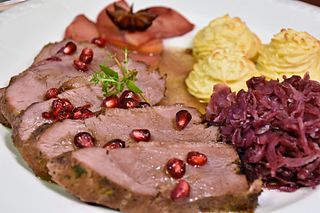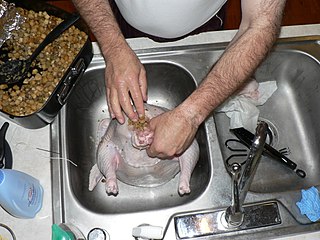 W
WA ballotine is traditionally a de-boned thigh and/or leg part of the chicken, duck or other poultry stuffed with forcemeat and other ingredients. It is tied to hold its shape and sometimes stitched up with a trussing needle. A ballotine is cooked by roasting, braising or poaching. A ballotine is often shaped like a sausage or re-formed to look like the leg, often with a cleaned piece of bone left in the end.
 W
WEngastration is a cooking technique in which the cook stuffs the remains of one animal into another animal. The method supposedly originated during the Middle Ages. Among the dishes made using the method is turducken, which involves placing chicken meat within a duck carcass within a turkey. Some foods created using engastration have stuffing between each layer. The carcasses are normally deboned before being placed together.
 W
WPuffin is a culinary speciality of the Faroe Islands, in the North Atlantic Ocean. Atlantic puffins breed in the islands in large numbers, notably on Mykines, and from July, after the breeding season, it is legal to catch them for food.
 W
WKhoresh-e fesenjān, or simply fesenjān, is an Iranian stew from Gilan province, Iran. It is flavored with pomegranate paste and ground walnuts and spices like turmeric, cinnamon, orange peel, cardamom, and rosebud. It is traditionally made with eggplant and poultry. Fesenjān can also be made using balls of ground meat or chunks of lamb. Depending on the recipe, it can have a sweet or sour taste. Fesenjān is served with Iranian white or yellow rice. It is part of the dinner table on Shabe Yalda celebrations. It is also eaten in the Azerbaijan Republic.
 W
WFoie gras is a specialty food product made of the liver of a duck or goose. According to French law, foie gras is defined as the liver of a duck or goose fattened by gavage. In Spain and other countries, it is occasionally produced using natural feeding. Ducks are force-fed twice a day for 12.5 days and geese three times a day for around 17 days. Ducks are typically slaughtered at 100 days and geese at 112 days.
 W
WMuttonbirding is the seasonal harvesting of the chicks of petrels, especially shearwater species, for food, oil and feathers by recreational or commercial hunters. Such hunting of petrels and other seabirds has occurred in various locations since prehistoric times, and there is evidence that many island populations have become extinct as a result. More recently ‘muttonbirding’ usually refers to the regulated and sustainable harvesting of shearwaters in Australia and New Zealand. These include the short-tailed shearwater, also known as the yolla or Australian muttonbird, in Bass Strait, Tasmania, as well as the sooty shearwater, also known as the titi or New Zealand muttonbird, on several small islands known as the Muttonbird Islands, scattered around Stewart Island in the far south of New Zealand.
 W
WPheasant under glass is a poultry dish generally composed of the breast of pheasant with shallots in a reduced wine sauce, although recipes will vary. While the dish has waned in popularity over many decades, it remains a cultural icon for many in westernized countries. Pheasant under glass is traditionally served on a plate that is covered with a glass dome.
 W
WRoast goose is a dish found in Chinese, European, and Middle Eastern cuisines. The goose is in the biological family of birds including ducks, geese, and swans, known as the family of Anatidae. The family has a cosmopolitan distribution. Roasting is a cooking method using dry heat with hot air enveloping the food, cooking it evenly on all sides. Roasting can enhance flavor. Many varieties of roast goose appear in cuisines around the world.
 W
WA salmis [sal.mi] is a preparation from classical French cooking. When a roast or sautéed piece of meat is sliced and reheated in sauce, the result is a salmis.
 W
WStove Top is a stuffing that was introduced by General Foods in 1972. It is a quick cooking ("instant") stuffing that is available in supermarkets. Unlike traditional stuffing, Stove Top can be prepared on the stove, in a pot, and can also be prepared in a microwave oven. It is used as a side dish for meals as well as a medium in which some meats can be baked. It is sold in boxes and canisters. In 2005 it was reported that Kraft Heinz, which has owned the brand since 1995, sells about 60 million boxes of Stove Top stuffing at Thanksgiving.
 W
WStuffing, filling, or dressing is an edible mixture, normally consisting primarily of small cut-up pieces of bread or a similar starch and served as a side dish or used to fill a cavity in another food item while cooking. Many foods may be stuffed, including eggs, poultry, seafood, mammals, and vegetables, but chickens and turkey are the most common. Stuffing serves the dual purpose of helping to keep the meat moist while also adding to the mix of flavours of both the stuffing and the thing it is stuffed in.
 W
WTetrazzini is an American dish made with diced poultry or seafood and mushroom in a butter/cream and cheese sauce flavored with wine or sherry. It is served hot over linguine, spaghetti, egg noodles, or some other types of pasta, garnished with parsley, and sometimes topped with breadcrumbs, almonds, canned fried onions, or cheese. Tetrazzini can be prepared as a baked noodle casserole, sometimes with steps taken to give it a browned crust. Shortcut recipes for home cooking sometimes use canned cream of mushroom soup or other cream soups.
 W
WTurducken is a dish consisting of a deboned chicken stuffed into a deboned duck, further stuffed into a deboned turkey. Outside of the United States and Canada, it is known as a three bird roast. Gooducken is a traditional English variant, replacing turkey with goose.
 W
WTurkey bacon is a meat prepared from chopped, formed, cured, and smoked turkey, which is commonly marketed as a low-fat alternative to pork bacon. Turkey bacon may also be used as a substitute for bacon where religious restrictions forbid the consumption of pork.
 W
WTurkey ham is a ready-to-eat, processed meat made from cooked or cured turkey meat, water and other ingredients such as binders. Turkey ham products contain no pork products. Several companies in the United States produce turkey ham and market it under various brand names. It was invented circa 1975 by Jennie-O who first introduced it to consumers that year. Around January 1980, the American Meat Institute tried to ban use of the term "turkey ham" for products that are composed solely of turkey and contain no pork.